

B2B Webinars: 10 Essential Tips to Maximize Engagement in Your Next Powerful Webinar
The abbreviation B2B stands for Business To Business, with B2B webinars being live online or recorded affairs targeted at delivering value information, insight, and training to professionals within specific industries or sectors. These webinars are typically highlighted by expert speakers, case studies, product demonstrations, or thought leadership discussions to influence one specific audience, such as other industries’ decision-makers, marketers, or another kind of key stakeholder. With more digital communication, B2B webinars play a vital role in terms of businesses communicating and engaging with the target audience to foster relations.
The role of B2B webinars becomes very critical in times when working remotely and sitting in front of digital devices has become routine. For companies, webinars offer a unique platform for sharing knowledge, proving their worth, and building real connections with potential clients. They are supposed to serve as a means to lead generation and prospect nurturing, industry credibility building, and real-time engagement through Q&A and discussions that feature an increase in the general learning curve and building a community of participants. With businesses relying more and more on digital marketing strategies, using webinars within outreach efforts can bring huge benefits to the table, truly making them one of the ingredients for success within any B2B marketing strategy.
How Can Webinars Showcase B2B Web Development Skills?
B2B webinars are an excellent channel for showcasing dynamic and engaging B2B webinars that highlight web development skills and expertise. Through live or pre-recorded sessions, developers can share their technical knowledge, best practices, and the latest tools in the field. This not only enhances credibility but also positions them as industry thought leaders. For example, a detailed case study presented in a B2B webinar can walk the audience through the design and development process, addressing challenges faced and solutions implemented. Such presentations not only showcase the developer’s skills but also provide practical insights that attendees can apply to their projects.
B2B webinars can offer interactive learning experiences, including live demos and hands-on tutorials. In these sessions, developers engage participants by providing step-by-step guidance on specific web development techniques. This interaction fosters questions and discussions, helping attendees gain a deeper understanding of complex topics while observing the developer’s problem-solving skills in real-time. For example, through live coding, attendees can witness the developer’s thought process and methods for addressing web development challenges, enhancing the overall learning experience and showcasing their practical abilities and communication skills.
B2B Webinars can also build a networking opportunity. It brings together professionals from various industries and different walks of life. By hosting guest speakers or partnering with other experts, a developer can increase his coverage area and showcase his skills to work in a team or even lead discussions on critical industry-related issues. This collaboration speaks not only to their skills but also to their commitment to keeping themselves abreast of current trends and innovations in web development. Overall, a webinar is a strong tool for showing off one’s skills and engaging with the audience to build valuable relations in the industry as far as B2B professionals in web development go.
What Key Features Make Webinars Engaging?
To keep the attention of attendees during B2B webinars, it’s essential to incorporate features that enhance the quality of the experience. The most critical component is interactivity. By adding polls, Q&A sessions, and live chat, participants can actively engage with the presenter and contribute to the discussion. This interactivity not only maintains attendees’ attention but also fosters a sense of community and collaboration. For instance, incorporating live polls provides instant feedback and insights, allowing the presenter to address the audience’s interests and preferences effectively.
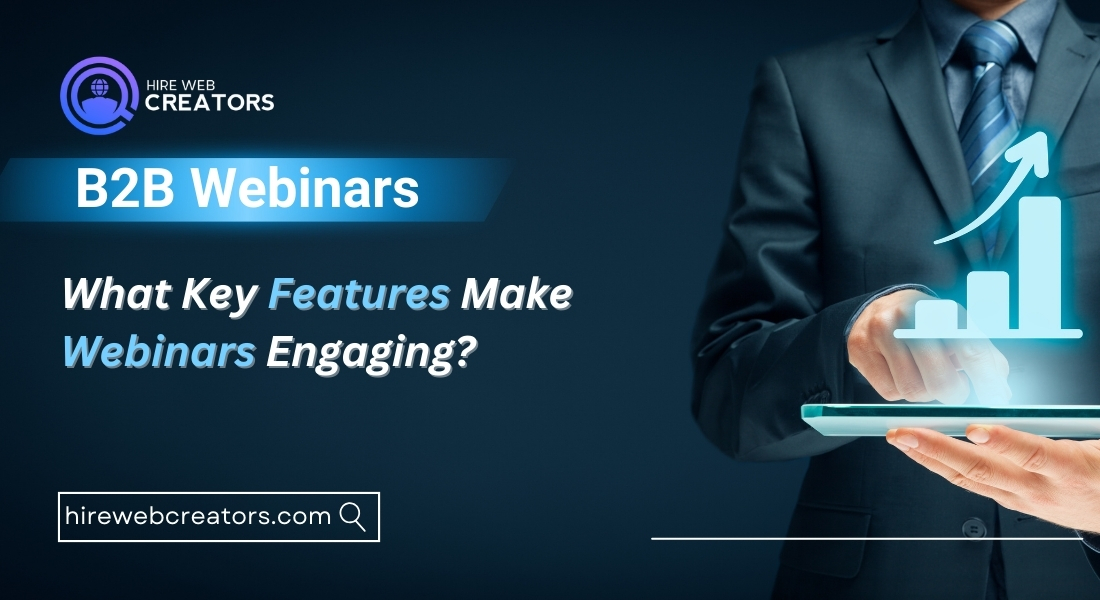
The key feature that fosters engagement in B2B webinars is high-quality visuals and rich multimedia content. Videos, infographics, and animations make the information more digestible and visually appealing. A well-designed presentation incorporating various media types keeps the audience’s interest and reinforces the message. For instance, a developer showcasing a web project might use before-and-after screenshots, user journey maps, or demo videos to illustrate the impact of their work. This variety enhances understanding and retention in the minds of the audience.
Another important component of achieving interactivity in B2B webinars is storytelling. Speakers who share personal experiences, relate case studies or tell compelling stories can connect better with their audience. A narrative framework for technical content fosters an emotional connection, keeping the audience engaged throughout the session. This storytelling approach helps participants relate their experiences to the topic, making it more relevant and applicable. By combining interactivity, multimedia, and engaging storytelling, B2B webinars create an impactful experience that resonates with attendees.
How to Choose the Right Platform for Hosting Webinars?
Choosing the appropriate platform to host B2B webinars is crucial for delivering seamless, engaging experiences to both presenters and attendees. Here are several key considerations when selecting a webinar platform for your B2B webinars:
Features and Functionality: Look for a platform that offers essential features such as high video and audio quality, screen sharing, and interactive tools like polls and Q&A. Additionally, the platform should support a sufficient number of participants and provide options for customization, including branding and layout choices. A user-friendly interface can significantly enhance the experience for both presenters and attendees during B2B webinars.
Integration Capabilities: Ensure that the webinar platform integrates smoothly with other tools you use, such as customer relationship management (CRM) software, email marketing platforms, and social media. This integration can streamline your workflow, automate tasks, and enhance your marketing efforts. For instance, if you want to follow up with attendees after the B2B webinars, having integration with your email marketing tool can facilitate that process.
Cost and Scalability: Evaluate the pricing plans of different platforms to determine if they fit within your budget. Some platforms may charge per webinar, while others offer subscription models. Assess the scalability of the platform, as you may need to host larger B2B webinars or conduct more frequent sessions as your business grows. It’s essential to choose a platform that can accommodate these changes without requiring a complete overhaul.
Support and Resources: Look for a platform that provides excellent customer support and resources, such as tutorials, guides, and troubleshooting assistance. Having reliable support can be invaluable, especially if you encounter technical issues during a live session. Additionally, some platforms offer analytics and reporting features that allow you to track engagement metrics and assess the success of your B2B webinars, providing insights for future improvements.

By carefully considering these factors and conducting thorough research, you can choose a webinar platform that aligns with your specific needs and goals, ensuring a successful and engaging experience for your audience.
What Content Should Be Included in a B2B Webinar?
One of the major reasons for developing attention-grabbing content for any B2B webinar is to engage your target audience’s interest in value delivery. Here are key elements to include in your B2B webinars:
Introduction and Agenda: Start with a clear introduction that outlines who you are, your organization, and the purpose of the B2B webinar. Set the stage by providing an agenda that highlights the main topics you’ll cover, allowing participants to understand what to expect. This structure helps keep your audience engaged and gives them a reason to stay for the entire session.
Industry Insights and Trends: Incorporate relevant industry insights and current trends into your B2B webinars to provide context for the discussion. Sharing data, statistics, and research findings can help establish your authority and credibility. This information not only informs the audience but also demonstrates your expertise and understanding of the challenges and opportunities within their industry.
Case Studies and Real-World Examples: Use case studies or real-world examples in your B2B webinars to illustrate your points. These examples can showcase successful implementations of your products or services, highlighting their effectiveness in solving specific problems. By presenting relatable scenarios, you can help attendees visualize how they might apply your solutions in their businesses.
Interactive Q&A Sessions: Include interactive Q&A sessions throughout your B2B webinars or at the end to encourage audience participation. Allowing attendees to ask questions can clarify doubts, foster engagement, and create a sense of community. Consider using polling tools or chat features to solicit questions in real-time, making the experience more interactive.
Actionable Takeaways: Conclude your B2B webinar with actionable takeaways that participants can implement in their businesses. Summarize the key points discussed and provide specific recommendations or strategies they can apply. This not only reinforces the value of your content but also encourages attendees to view your organization as a trusted resource for further information.
By incorporating these content elements into your B2B webinars, you can create a rich, engaging experience that resonates with your audience, builds relationships, and drives meaningful conversations around your products or services.
How to Promote Your Webinar Effectively?
One has to promote the B2B webinar to have a large audience and ensure maximum engagement. A good promotion strategy includes several channels and tactics that should enable your target audience to learn about the webinar. The following are important strategies to promote your webinar to success:
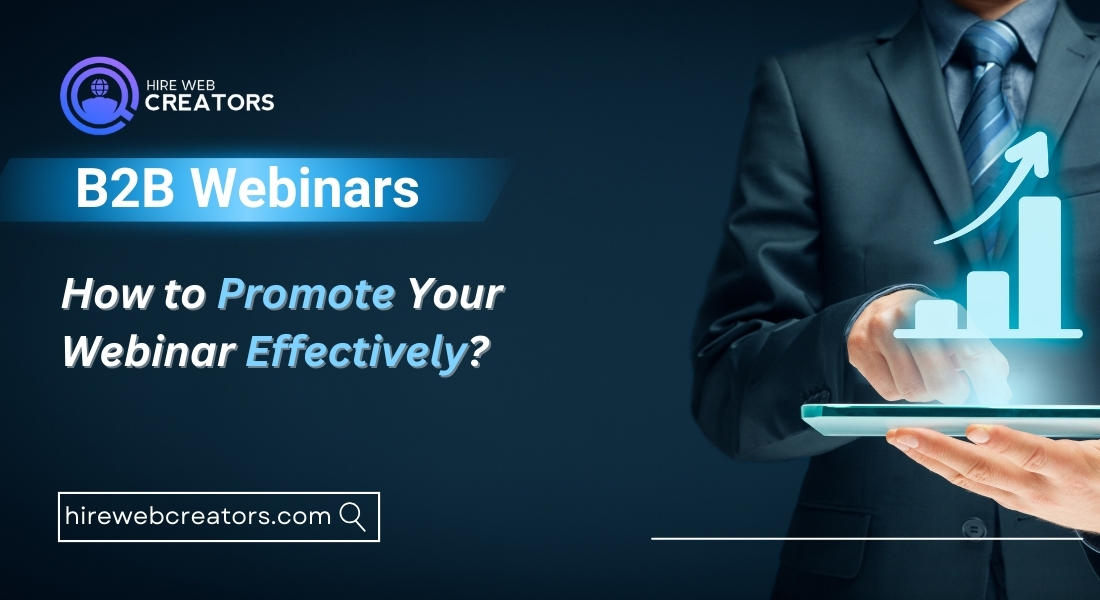
- Email Marketing: Leverage your existing email list to announce B2B webinars. Craft engaging emails that highlight the value of the B2B webinars, include key details (date, time, topic), and provide a clear registration link. Consider sending reminder emails as the event date approaches to keep interest high.
- Social Media Promotion: Utilize your social media platforms to promote B2B webinars. Create eye-catching posts that include visuals, relevant hashtags, and direct links to the registration page. Engage with your audience by sharing countdowns, sneak peeks of the content, and reminders to register for the B2B webinars.
- Landing Page Creation: Develop a dedicated landing page for the B2B webinars that includes all relevant information, such as the topic, speakers, schedule, and registration form. Ensure the page is optimized for conversions, with a clear call to action encouraging visitors to sign up.
- Leverage Influencers and Partners: Collaborate with industry influencers or partners to promote the B2B webinars to their audiences. This expands your reach and can lend credibility to the event. Offer them a guest speaking slot or other incentives for their support in promoting your B2B webinars.
- Content Marketing: Create blog posts, articles, or videos related to the B2B webinar topic in advance. Share this content across your platforms to generate interest and encourage registration. Incorporating SEO strategies can help attract organic traffic to your B2B webinars.
- Webinar Series: If you plan to host multiple B2B webinars, consider creating a series on a related theme. Promote the series as a valuable learning opportunity, encouraging participants to register for all sessions for comprehensive insights into B2B webinars.
- Paid Advertising: Consider utilizing paid advertising on social media or search engines to target specific audiences for your B2B webinars. Create compelling ad copy that highlights the benefits of attending and drives traffic to your registration page.
- Engage Previous Attendees: Reach out to individuals who attended your previous B2B webinars. Encourage them to register for the new session by highlighting what’s new and different. This strategy can help increase attendance from an already interested audience.
- Reminder Emails and Notifications: As the B2B webinar date approaches, send reminder emails to registered participants. Include information on how to join the B2B webinars and encourage them to invite colleagues or peers who might benefit from the content.
- Post-Webinar Content: After the B2B webinars, share recordings, key takeaways, and resources with attendees and those who registered but couldn’t attend. This follow-up can encourage them to participate in future B2B webinars and engage further with your brand.
- 4o mini
What Are the Best Practices for Webinar Delivery?
Proper planning combined with its proper execution is key to delivering a successful B2B webinar. Best practices that will ensure the smooth running of your webinar and keep it engaging for viewers are:
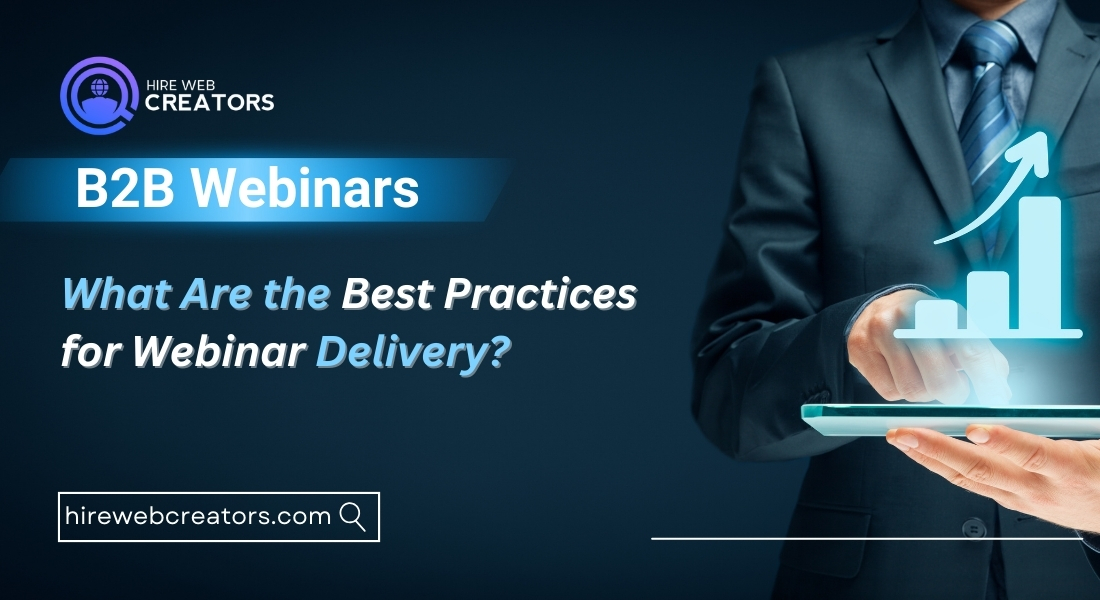
- Engaging Presentation Style: Your delivery style can significantly impact audience engagement. Use a conversational tone to make the content relatable and encourage interaction. Vary your voice and pace to maintain interest, and incorporate storytelling techniques to illustrate points. Visual aids, such as slides or videos, should complement your spoken content and help convey your message.
- Technical Preparation: Ensure that all technical aspects are addressed before the webinar begins. Test your audio, video, and presentation software to prevent any glitches during the session. Familiarize yourself with the platform’s features, such as screen sharing, chat, and polling tools, to maximize engagement. It’s also wise to have a backup plan in case of technical difficulties, such as a secondary device or internet connection.
- Promote Audience Interaction: Encourage audience participation throughout the webinar to keep them engaged. Use interactive tools like polls, quizzes, and chat features to solicit feedback and questions. Consider incorporating breakout sessions for smaller group discussions, which can enhance the learning experience. Acknowledge audience contributions by responding to questions or comments in real-time, creating a sense of community.
- Clear and Structured Content Delivery: Organize your content logically and ensure a smooth flow from one topic to another. Use signposts to guide your audience through the presentation, reminding them of key points and transitioning between sections. Keep each segment concise to maintain attention, and be mindful of the overall webinar duration to respect participants’ time.
- Follow-Up After the Webinar: After the webinar concludes, send a follow-up email to attendees thanking them for their participation. Include a link to the recorded session, any relevant resources, and answers to questions that were raised during the Q&A. This follow-up helps reinforce your message and keeps the conversation going, allowing you to build relationships and provide further value to your audience.
Implement these best practices for webinar delivery, you can create a more engaging and impactful experience for your audience, ultimately enhancing the effectiveness of your B2B webinars and fostering stronger connections with potential clients
How to Interact with Your Audience During Webinars?
Engagement is vital within webinars to activate curiosity, impel increased interest, foster participation, and ensure overall value. Here are a few effective strategies to engage your audience during your B2B webinars:
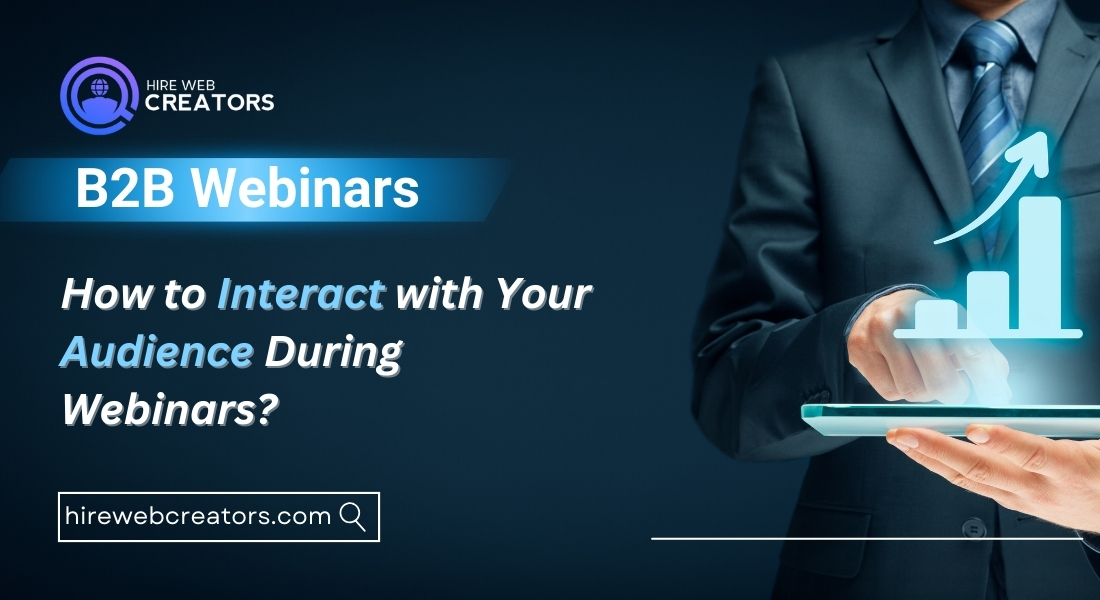
- Utilize Interactive Features: Most webinar platforms offer various interactive tools such as polls, quizzes, and chat functions. Incorporate live polls to gauge audience opinions on topics discussed, or quiz them on key concepts to reinforce learning. This not only keeps the audience engaged but also provides valuable insights into their understanding and preferences.
- Encourage Questions Throughout Create a culture of openness by encouraging participants to ask questions throughout the presentation. Designate specific times for Q&A sessions, but also invite questions in real-time to keep the conversation flowing. If participants are hesitant to speak up, consider using the chat feature to allow them to submit questions anonymously, which can help increase engagement.
- Respond to Comments and Questions: Actively monitor the chat for questions or comments during your presentation. Acknowledge participants by name when responding to their inquiries, which fosters a sense of connection and appreciation. Even if you can’t answer every question during the webinar, assure participants that you’ll follow up after the session with any unanswered questions, demonstrating your commitment to their engagement.
- Incorporate Breakout Sessions: For larger webinars, consider using breakout rooms to facilitate smaller group discussions. This allows participants to interact more intimately, share their thoughts, and collaborate on ideas related to the webinar topic. After the breakout session, bring everyone back together to discuss insights gained, ensuring that the entire group benefits from the shared knowledge.
- Use Real-Life Scenarios and Case Studies: Encourage interaction by discussing real-life scenarios or case studies that relate to your audience’s experiences. Ask participants how they would approach certain challenges or solutions. This not only engages them in problem-solving but also allows for sharing diverse perspectives, enriching the discussion.
- Follow-Up with Participants: After the webinar, send a follow-up email thanking attendees for their participation. Include a survey to gather feedback on their experience and invite them to ask any additional questions or share thoughts. This not only shows that you value their input but also opens the door for continued interaction and relationship-building.
These interactive strategies can create a more engaging and dynamic webinar experience that encourages audience participation, enhances learning, and builds lasting connections with your attendees.
What Metrics Should Be Tracked After Your Webinar to Evaluate Success?
Knowing how to measure the success of your B2B webinar is an important step toward understanding what effect it is going to have and what needs to be improved in its organization. Here are key metrics to track after your webinar:
- Attendance Rate: The attendance rate is a crucial metric that indicates the percentage of registrants who attended the webinar. To calculate this, divide the number of attendees by the number of registrations and multiply by 100. A high attendance rate suggests that your promotional efforts were effective and that the topic resonated with your audience.
- Engagement Levels: Measure engagement levels during the webinar by tracking participant interactions, such as questions asked, polls answered, and chat activity. High engagement levels indicate that your content was compelling and that attendees were actively involved. Many webinar platforms provide analytics that shows real-time engagement metrics, allowing you to assess which sections of your presentation sparked the most interest.
- Audience Retention: Audience retention refers to the percentage of attendees who stayed for the entire webinar versus those who dropped off at different points. This metric can help you identify which segments of your presentation were most engaging and which parts may have caused disengagement. High retention rates suggest that your content was valuable, while lower rates may indicate areas that need improvement.
- Post-Webinar Surveys: Conducting post-webinar surveys is an effective way to gather qualitative feedback. Ask participants about their overall satisfaction with the webinar, the relevance of the content, and any suggestions for future topics. This feedback can provide valuable insights into how well you met your audience’s needs and expectations.
- Lead Generation and Conversion Rates: One of the primary goals of a B2B webinar is to generate leads. Track the number of leads generated during the webinar, including new contacts added to your mailing list or those who expressed interest in your products or services. Additionally, analyze conversion rates to see how many of these leads went on to become customers. This metric is crucial for assessing the ROI of your webinar.
- Follow-Up Engagement: After the webinar, monitor engagement with follow-up content, such as emails, recordings, or additional resources you provide. Track metrics like open rates, click-through rates, and downloads to evaluate how effectively you maintained interest and continued the conversation with your audience.
- Social Media Engagement: If you promote your webinar on social media, track the engagement metrics on those platforms. This includes likes, shares, comments, and mentions related to your webinar. Social media engagement can help you assess the overall impact of your marketing efforts and gauge interest in future webinars.
By closely monitoring these metrics, you can gain valuable insights into the effectiveness of your webinar, identify areas for improvement, and refine your strategy for future sessions. This data-driven approach will enhance your ability to create engaging and successful webinars that resonate with your B2B audience.
What Are Common Pitfalls to Avoid When Creating and Delivering Webinars?
Any effective webinars call for planning and execution. The most common mistakes, however, can destroy this effort. Not having clear objectives is one of the major missteps. Without having set clear goals, success will be difficult to measure, and relevant content will be hard to create. Before you get started with your webinar, it’s important to define what you want to achieve: generate leads, educate an audience, or possibly demonstrate a product. Setting clear objectives will help you focus your content development and promotional strategies on what matters and will ensure that your webinar goes off without a hitch with your intended audience.
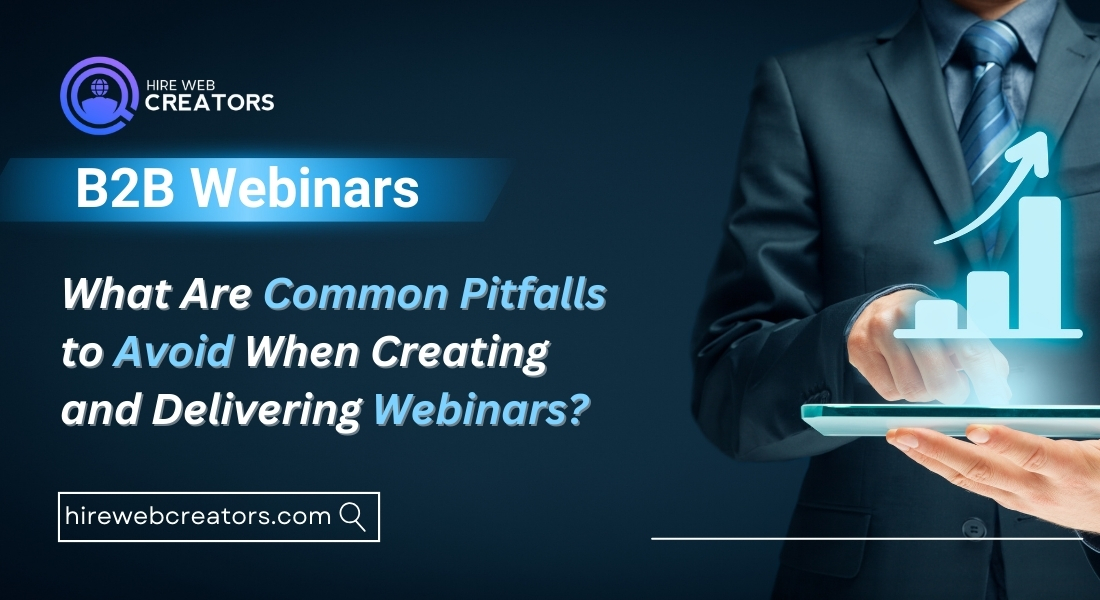
Another common mistake is failing to research the target audience for B2B webinars, which can lead to content that doesn’t resonate with participants. Understanding your audience’s demographics, interests, and pain points is crucial for delivering relevant content. Avoid overwhelming them with excessive information; instead, focus on clear takeaways delivered concisely with effective visuals and storytelling. This approach ensures your B2B webinars remain engaging and impactful.
Technical preparation is crucial for successful B2B webinars, as poor performance can disrupt the entire experience. Ensure all equipment, software, and internet connections are tested well in advance. Familiarize all speakers with the platform’s features and have a backup plan ready. Engage your audience with polls, Q&A sessions, and other interactive elements to maintain interest. Additionally, send follow-up communications, including thank-you emails and recordings, to reinforce the value of your content and encourage further engagement. By addressing these aspects proactively, you can create impactful B2B webinars that achieve your objectives while impressing your audience.
B2B webinars play a significant role in showcasing web development (B2B Website Personalization) skills by providing a platform for professionals to share knowledge, demonstrate expertise, and engage audiences. By utilizing engaging formats and interactive elements, businesses can establish themselves as thought leaders, enhancing their reputation and credibility. Webinars facilitate skill demonstration, knowledge sharing, and community engagement, allowing participants to collaborate in real-time through shared insights and questions. This interaction further strengthens the relationship between businesses and their audiences, fostering trust and potential partnerships.
It’s not just that the live event does; webinars do much more. Those can be repurposed down the line for future marketing efforts, which often extends the reach and continually gives businesses a way to show off their subject matter expertise. Engagement metrics and audience feedback enable an organization to improve its approach toward future webinars continuously, ensuring improvement and relevance. Webinars will turn out to be among the most influential tools of education, skill sharing, and drivers of growth in businesses once B2B web development matures, keeping companies upfront in competition.
